Ethnography has become the new marketing buzzword, a must-have in a designer toolkit, and a simple shorthand for qualitative research. Doing “ethnography” usually means using people-studying tools as part of a mixed bag of observation and interviews for data collection. If design is social, and we all seem to agree that it is, then ethnography is the means to access this sociality.
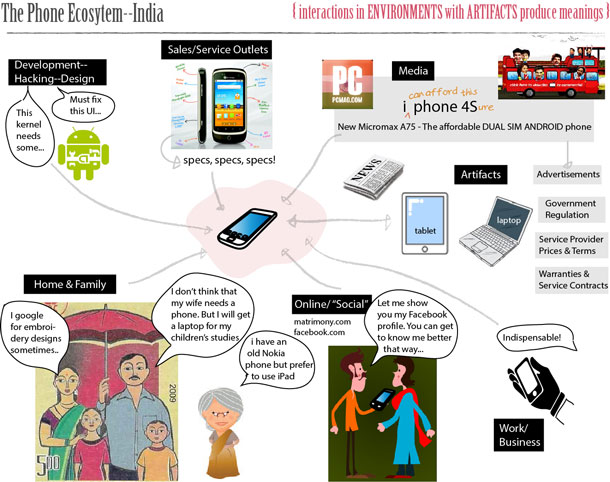
What is often not audible above the industry buzz is just
how doing in-field ethnographic research translates into actual design ideas or guidelines, or adds value to the design process. We make two related propositions: first, that ethnographic insight derives not merely from designing methodologies for field research, but from orienting ourselves analytically to the topics of our study in ways that get at cultural dynamics—big and subtle—at all stages of research and analyses. And second, closely following from our first proposition, that ethnography is, fundamentally, a method of cultural analysis, or method of discovering and explicating cultural processes. Asking the right questions in the right ways means that we move towards grasping these processes, concepts, analogies, and ways of thinking—that can then serve frameworks for design. The idea is not merely to deploy ethnography as the next most valuable data gathering methodology, but to think ethnographically about the process of design itself.
But what constitutes an ethnographic orientation? How could cultural analysis lead us more effectively towards meaningful, sensitive, user-centered design?
Our first step is to conceptualize, however roughly at first, the microcosms or lifeworlds we are seeking to understand. In the beginning, there is often not a user group or even a practice, but an object or an artifact that centers our investigations: a phone, a washing machine, an e-commerce website, a food product. “What” usually comes before “who,” “where,” or “how,” but if we were to think along the lines suggested by anthropologist Arjun Appadurai in
The Social Life of Things, objects have social lives, too. They are owned, loved, used, consumed, cared for, or neglected. They circulate, create value(s), identifications, and bind or break relationships. Our first task, then, is to conceptualize this lifeworld, or what we call an
ecosystem, and to allow it to lead us toward communities of users and their social dynamics.
Ever since James F. Moore first proposed the idea of the “business ecosystem” in theHarvard Business Review (1993), the idea of the ecosystem has expanded to refer to other more-or-less self-contained “worlds” in which participants compete, cooperate, and co-evolve. Cultural ecosystems can revolve around products, services, or communities/groups. They contain not only task flow processes, but also the human social interactions that take place, are avoided, or enabled around—or as a result of—task flows. These, in turn, point to symbolic, aspirational, or other cultural themes that conceptually define how a given ecosystem works.
Within this space, a series of questions first map the terrain, and next investigate its logic, its mechanisms, and its cultural underpinnings. What is happening in the different environments of a given ecosystem? Who are the participants? How are they interacting? What are they feeling and experiencing in these various engagements? What are the objects that circulate in this ecosystem and how do these acquire significance? What local realities or cultural elements are at play? (Figure 1)
Figure 1. Example of a model of a phone ecosystem that shows how different participants (different user groups, developers, regulators, etc.) layer meanings onto the object, facilitating both brand value creation and complex personal meaning-making, derived from research done in India. (Image credit: Deepa S. Reddy)
Ethnographers answer these questions in two ways:
- Close observations and dynamic interview scripts that help to identify what is happening and how it is happening.
- Interpretive strategies of cultural analysis that identify why things are happening the way they are.
The anthropologist’s “ecosystem” is thus not just a space in which people live and function, but one in which their values, identifications, and aspirations are writ large, to be uncovered by cultural analysis.
These are some of the many strategies that anthropologists use to uncover local particularities and the symbolic dimensions of social interaction.
A Cultivated Naiveté
The classic ethnographic strategy of “defamiliarization” deliberately cultivates naiveté as a research strategy so as not to presume the meaning of any artifact or practice, but to lay bare its meanings. Anthropologists Rita Denny and Patricia Sutherland ask, for example, “What is an office?” and “What is coffee?” to investigate physical-metaphoric dimensions of workspace organization and consumption practices. The former question has implications for translating physical desktops into digital ones (Figure 2); the latter for redesigning “social places” and for product positioning.
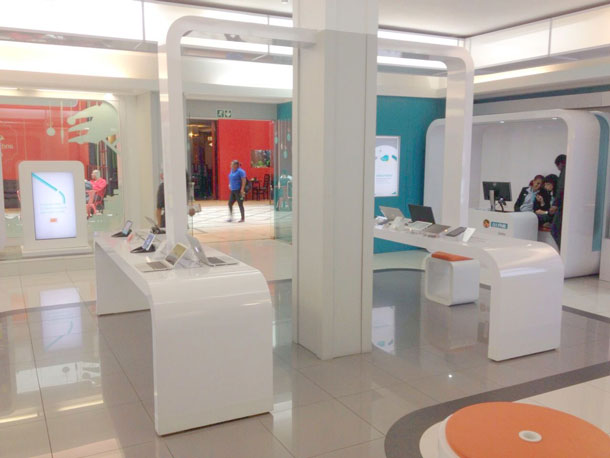
Figure 2. What’s a bank? Johannesburg, South Africa. New model of retail banking that seemed to trouble customers. (Image credit: Deepa S. Reddy and Diane Devar)
Cultural Practices: Objects as Metaphors
Metaphors offer a second approach to cultural analysis (a little different from the
methods sometimes used in UX design). We often experience some kinds of things in terms of other kinds of things: gadgets as personal assistants, bodies as machines, and clothing as identity. As a tool of cultural analysis, the metaphor allows us to map the connections between apparently unconnected things.
Cultural views of “snacks” can tell stories of time between meals: of boredom, isolation, health, as well as socialization. Lifelogging (figure 3), technology-inflected self-experimentations can be experienced as practices of “mindfulness.” Metaphors reveal the cultural associations that make objects or practices meaningful in those particular contexts. Mapping ideas and associations at this subtle, experiential level means that products can be situated meaningfully—and imaginatively—in specific cultural landscapes.
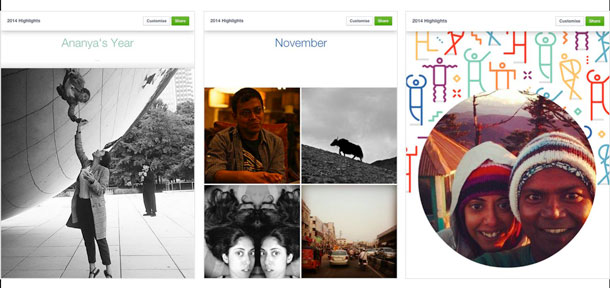
Figure 3. Lifelogging: Facebook Lookback (Screenshots from Ananya Roy’s Facebook profile)
The Jeweler’s Eye View
When a jeweler looks through his loupe, what does he see? Taking inspiration from
Michael Fischer’s articulation, this “means not only the ability to bring out the different facets of cultural variability, but also a constant back and forth movement between close-up viewings and sitting back for a more global view of the settings.” Ethnography’s attention to rich, specific cultural detail is paired with more distanced “big picture” global views—such that micro- and macro-realities can be meaningfully connected. Preserving certain offerings globally (as McDonald’s once did with its broad commitment to accessible toilets), or understanding how global landscapes produce their own metaphors and dynamics, can be as critical to business success as understanding where to localize products and services. (Figure 4)
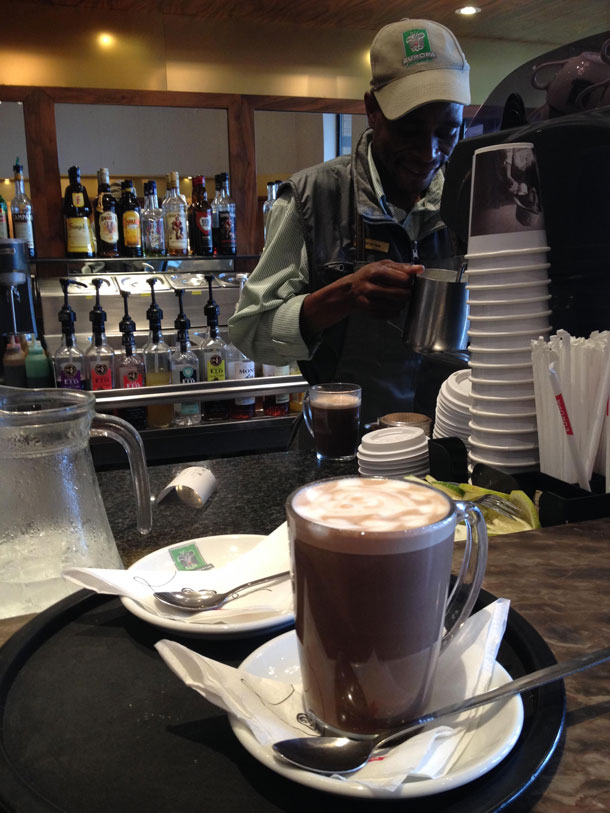
Figure 4. Serving mocha lattes at an upscale eatery in Nelspruit, South Africa. What is the restaurant worker’s relationship to the globally recognizable drink he prepares for patrons—but cannot himself afford? (Image credit: Deepa S. Reddy)
These strategies provide insights into how ethnography as a method of cultural analysis can help us not just document practices, but understand their symbolic and conceptual meanings. Knowing why people act, feel, think, experience, and choose the way they do gives us rich cultural insights to inform design or to build meaningful, empathetic user experiences. But how do such insights emerge?
The following three sections illustrate cultural insights that can be generated and applied using the above strategies, based on our own research experiences, as well as those of other ethnographic studies. Each begins from a position of cultural naiveté, presents cultural insights uncovered via ethnographic study, and proposes ideas for design application.
Romancing the Phone
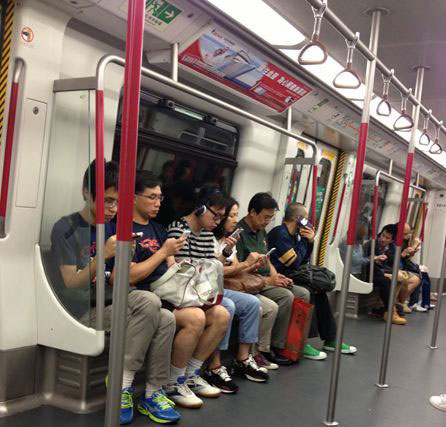
Figure 5. A digitized public on the Mass Transit Rail in Hong Kong. (Image credit: Deepa S. Reddy)
In the familiar scene shown above in Figure 5, passengers in Hong Kong’s Mass Transit Rail are each absorbed by activities on their mobile devices. What each individual phone user is doing with their device is not discernible from afar, but when people are traveling or walking together, it is often evident that young couples (for example) are romancing their phones. Even while face-to-face, they are sharing photos, sending texts, scrolling chat screens together, and getting to know each other via their respective social networking profiles. What the phone is, in this instance, is an object of intimacy and courtship.
We know now intuitively what social theorist Anthony Giddens once noted: “A person may be on the telephone to someone twelve thousand miles away and for the duration of the conversation be more closely bound up with the responses of that distant individual than with others sitting in the same room.” Phones simulate proximity—to the point of displacing proximal relationships. But where is the need for such simulation when people are face to face? This particular use of the phone offers a critical insight: the simulation of proximity does not equal the negation of distance. A little distance, or a little mediation, can be electric, or a way of proceeding with caution. Both are vital catalysts of modern romance and relationship.
Design insights
- Personal devices and other contextual products can help expand the sensory experience of love and romance. The experience of psychological nearness through voice, text, and symbols can be broadened to create sensual nearness even when people are apart, through the simulation of physical experiences like a hand squeeze, a sensuous breath, a heartbeat, a kiss, or even a partner’s snoring.
- Appearance, sound, smell, touch, light, projection, holographics, and even apparently mundane elements like screen guards can be used to extreme-personalize one’s devices, present one’s self in the most desirable way, and engage the senses of an existing or potential beau. After a break-up, apps and life logging tools can track one’s moods and vitals to provide counseling and therapeutic crutches.
Design scenario
Angela has gifted her live-in boyfriend Zhao a Love Phone. It smells of her favorite perfume and alerts him to wake up every morning in her voice (while she is in a different place in the same apartment, getting ready or having breakfast). Zhao can play Angela’s live heartbeat on a pre-loaded app to ease himself to sleep after a grueling day while Angela stays up reading. On their joint commute back home they “selfie” themselves against exotic settings and share these images within their friend circle. Friends’ comments on how close they are, in spite of their busy schedules and personal interests, makes Angela proud of her Love Phone enhanced relationship.
Disruptive Exchanges
Gifts and exchanges are managed with much care and finesse in Japan. What is less obvious to casual observers are the precise mechanisms by which these are handled, and that they can cause acute embarrassment and social disruption.
Take the expression “arigata-meiwaku,” which refers to excessive, unsolicited acts of kindness which place recipients in a position of great obligation, even shame, for gestures which cannot be reciprocated. (An example is that of an American tourist who returns a dropped note to a fellow train passenger, only to have the grateful recipient of this courtesy return the favor by going hours out of his way to escort her to her final destination.) Meiwaku (annoyance, disturbance, or commotion) is to be avoided at all costs, as it creates or imposes obligations on others in ways that disrupt the fine balance of exchange practices.
Japan’s unique adaptation of Valentine’s Day gifting offers another example of a carefully managed disruption. The event is an occasion for women to give or strategically deny “giri-choco” or “obligation chocolates” to male family members, teachers, and particularly bosses, as a sign of amae or love, respect, and dependence—all values associated with women. (These gifts are then returned on “White Day” a month later via white confections.) The western origins of Valentine’s Day celebrations allow Japanese women to draw on ideas of women’s empowerment and individualism attributed to the “West,” briefly abandon conventional restraint, and express themselves openly in their workplaces, much to the embarrassment of ungifted superiors.
Clearly, even in a cultural context that so meticulously manages social exchanges, disruptions are not only possible, they are sometimes necessary to maintain a healthy social order. Clues to how disruptions work, where they might be bothersome, where they are useful, and in what quantum, are details to be identified only in systematic ecosystem research.
Design insights
- In “From Meiwaku to Tokushita!: Lessons for Digital Money Design From Japan,” Bill Maurer, Scott Mainwaring, and Wendy March suggest that digital money design should result in a “net decrease in commotion.” There should be neither any “new burdens [nor a decrease] in friction to a point of individual spending.”
- Piggyback on other distinctively western ideas that are already adopted and acceptable to capitalize on “Western” cachet and introduce controlled disruptions.
- Living with social hierarchies is, at times, not easy. Look out for acceptable opportunities to introduce relief, or to allow for rules to be subverted.
- Gamify the practices of gifts and obligations in fantasy spaces in order to test their limits!
Design scenario
The latest craze in Kyoko’s life is a virtual reality world called Big Meiwaku that allows one’s avatar to break every gift giving and reciprocation custom ever conceived. The more rude, unconventional, and devoid of etiquette one is on Big Meiwaku, the quicker they will move up the levels and be invited into elite clubs specializing in different brands of unsocial behavior. She and her friends spend their tea breaks and lunch hour glued to it, relishing the fantasies they know they won’t be able to satisfy in the real world for a long time to come.
Doing the Laundry
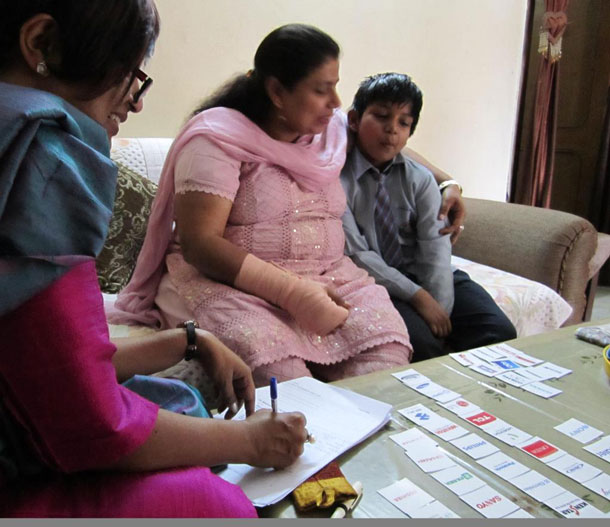
Figure 6. Ecosystem research on washing machines in India: a family shares their views on home appliance brands. (Image credit: Ananya Roy, 2011)
Other ethnographic studies have shown that laundry practices the world over express affective or emotional dimensions, attachments, and care—not just for the clothes—but for the people who will wear them (Figure 6). They can also express care for the environment, attitudes toward water and energy management, and associations with health, hygiene, freshness, cleanliness, tidiness, and more. Laundry is also a chore and a daily drudgery, but research with families invariably reveals that reducing a washing machine or a detergent to its efficiency, functionality, or even its convenience is to grossly understate its value.
Our own 2011 ecosystem research study with Indian households in Delhi, Mumbai, and Chennai found that the washing machine was not just another home appliance that reduced workload. One group of women from one of the three cities, typically from affluent-but-conservative extended families with little say in household decision making, expressed their self-worth by operating the washing machine. Interestingly, they had a preference for semi-automatic machines as these assured them substantial involvement and control of the process.
A second group of respondents from lower income nuclear families in another city, saw the washing machine as a tool of class mobility. The machine liberated them from the chore of cleaning and managing clothes and allowed them to use the extra time to attend to their personal development: higher studies, vocational courses, or a part-time job. This group preferred fully automatic machines.
Somewhat similarly, a third group of mothers of tweens to late-teens saw the washing machine as clearing time to help their children get ahead. The machine ensured their kids were well-groomed, and the mother was free to help with her children’s studies, run a well-organized, non-chaotic household, and breed well-balanced, successful, motivated children!
Design insights
- It’s not sufficient to emphasize machine functionality, or efficiency. Target features and appliances at different user groups, based on their motivations and aspirations.
- Design machines that allow users to visualize water or detergent use, or to see the volume of wastewater, in order to appeal to their sense of control (and guide them toward certain behaviors). Rather than assuming the need for pre-set washes and simple controls, return the decision-making power to users.
- Allow the machine to tell a story about life—your This is both a branding strategy and a more personal record-keeping mechanism. On one level the machine allows you to live the life you choose. On another, perhaps the machine could record the details of daily usage and produce a record, suggest fixes, educate, and generate encouragements.
- Smart machines, which communicate with personal devices, could aid in the above strategies.
Design scenario
Maya is a super busy mom of two school kids in Mumbai. Based on the first few days of use, her Mobile-Synced Microwave Washing Machine detected how dirty the kids’ clothes get, customized a washing option (detergent/duration/washing style/rinse combo) for her, and sent her the suggestion through its mobile app. Maya allowed the machine to go ahead and use the suggestion, and the clothes turned out so clean that she immediately messages the option to her other mom friends. Now she loads the clothes in the machine in the morning and initiates washing remotely through her mobile, at her own convenience, while she’s picking up her kids from school or waiting for them to finish violin lessons. She simply “messages” the machine to use the microwave function to repair clothes damaged during a sports event, or dry clothes on an especially rainy Mumbai day.
Conclusion
The examples above point to the following conclusions:
- Ethnography is more than a style of data-gathering. It is an analytical approach to making sense of the data gathered in close, immersive field studies.
- The many cultural insights gained from ethnographic studies in specific ecosystems are not obtainable through straightforward market research-style questioning.
- The ultimate value of ecosystem research for business and design lies in reading the ecosystem as a symbolic, conceptual universe, as well as a space of practical human interactions. Our needs and aspirations are most vividly expressed through the web of meanings that we create in our social exchanges, from which new ideas for design and innovation can most meaningfully emerge.
While there are no cut-and-dried formulae for extracting insights from ethnographic research, the strategies outlined above are useful starting points in the process of making sense of culture in ways that render it readable and open up the possibilities of further cultural analysis. Through these, our attention begins to be directed at uncovering the details of how interactions and relationships in the ecosystem are structured, how exchanges happen, how aspirations or dissatisfactions are expressed, and how native points of view are encapsulated in cultural forms and practices. Whether we are planning to get to field-based studies or are in the thick of field research, the objective is to identify the mechanisms by which human interactions generate culturally specific meanings—which are the crucial hooks to design and innovation.






